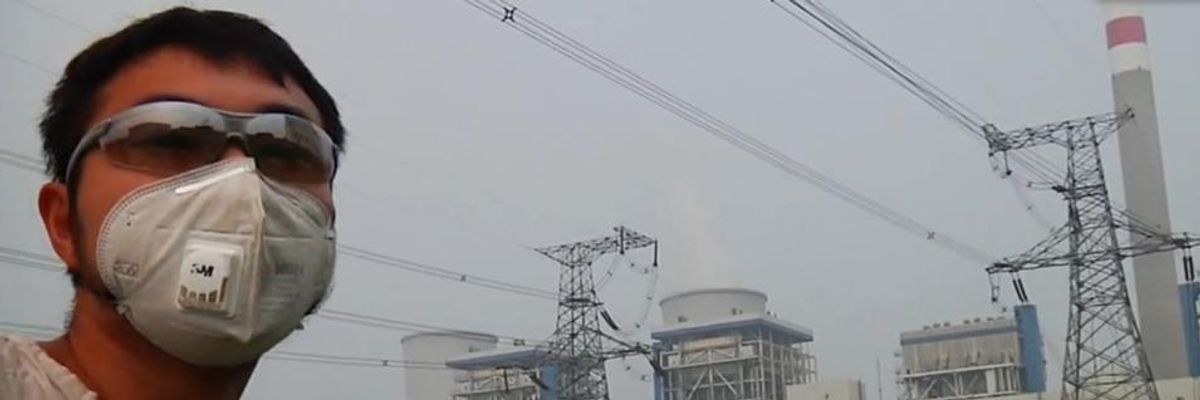The United States is undergoing a massive energy transition that isn't receiving enough attention, and it could render the Paris climate agreement meaningless. We're swapping one climate-damaging fuel, coal, for another that is actually worse: fracked gas.
It's a stark contradiction for U.S. climate policy. The Obama administration used its executive power to push the agreement and its aspirational goal of keeping warming to "well below" 2 degrees Celsius. The agreement is a good thing. But for the U.S., a big part of reaching its intended nationally determined contribution (INDC) commitment is implementing the Clean Power Plan, the EPA's framework for states to reduce their carbon emissions. It's designed to facilitate a wholesale transition from coal to natural gas, much of which is a product of fracking.
Phasing out coal is also a good thing, but replacing it with gas will send emissions soaring, and put that "below 2 degree" goal out of reach - that is, unless communities succeed in standing up to the fossil fuel industry and replacing coal with renewables, not gas. By themselves, current INDCs connected to the Paris agreement will lead to a 3.5-degree warmer future. Any hope of grounding Paris's lofty goals in reality depends on the grassroots acting fast to stop the gas industry juggernaut.
Gas power plants emit less CO2 than coal, so they sneak under the Clean Power Plan CO2 limits, and it's easy and cheap to swap gas burners for coal burners in existing power plants. But natural gas is mostly methane, which is about a hundred times more powerful than CO2 as a warming agent. Gas drilling, fracking, and transport via pipelines and compressors means massive amounts of it will leak directly into the atmosphere before it's even burned, swamping any potential gains in CO2 emissions for the global climate, while also causing local environmental and health damage.
The industry is currently proposing, and the Obama administration is busy approving, hundreds of power plants, hundreds of thousands of miles of pipelines, compressor stations, LNG terminals and other fracked gas infrastructure across America. It's like Keystone XL times 100 (in Roman numerals that would be Keystone CD, for "carbon dump"). They're ramming through the Constitution pipeline in upstate New York, the CPV power plant in Middletown, New York, the NED pipeline through New England, two massive gas fired power plants in Denton, Texas, the Millennium pipeline expansion in Pennsylvania, the Tennessee pipeline in West Virginia, the gas storage facility at Seneca Lake, New York, and on and on.
Local communities are fighting these projects across the country, but they are largely unconnected to each other and lack the tools and resources they need to win. We urgently have to change that, because unless they do win, we will have 40 more years of fracked gas extraction and usage built into the energy system, and we can forget about keeping warming under 2 degrees.
Here's the good news: Cities and towns can make the transition to renewables now. Some are succeeding in stopping fracked-gas infrastructure projects and winning bans and moratoria on fracking, but they know the only permanent ban is switching to a different energy source. Local grassroots support for renewables is strong and getting stronger, and there's a growing knowledge and experience base for how to translate it successfully to utility scale projects. Renewables are ready: Solar, wind, conservation, geothermal and some renewable fuels already work better than fossil fuels, and they're getting better all the time. There's lot of money to be made on investing in them, and those opportunities can match up with trillions that have been divested from fossil fuels.
In some places, like California and New York, there's a favorable state/local legislative environment for renewables. Portland, Oregon, has passed a resolution prohibiting new fossil-fuel development, and towns and cities across the West Coast are signing on. It's also true that in many places pro-renewables laws and regulations are under siege from fossil fuel interests and ALEC-backed bills are hindering renewables development. But at least we have some policy templates that states can follow.
If we can put these available elements together - know-how, financing and policy -- we can give communities the tools they need to say "no" to the massive buildup in gas infrastructure, and "yes" to viable, utility-scale renewable alternatives. Then renewables can scale up, local environments, safety and health won't be destroyed, and US emissions could fall to within range of the Paris targets.
I've made a new film, "How To Let Go of the World (and Love All the Things Climate Can't Change)" about the power of local communities to determine their own climate and energy solutions democratically, and reject the industry bid to lock in more fossil fuels for decades to come.
It's premiering at Sundance next month, then we're taking it on a grassroots solutions tour to 100 cities and towns on the front lines of the fight against dangerous fossil fuel infrastructure. We'll travel with experts and resources that can help them lead a renewable energy revolution, one community at a time. It's the locally determined contributions of communities like these, not the imposed agenda of the gas industry, that could put us within reach of Paris's aspirations.

